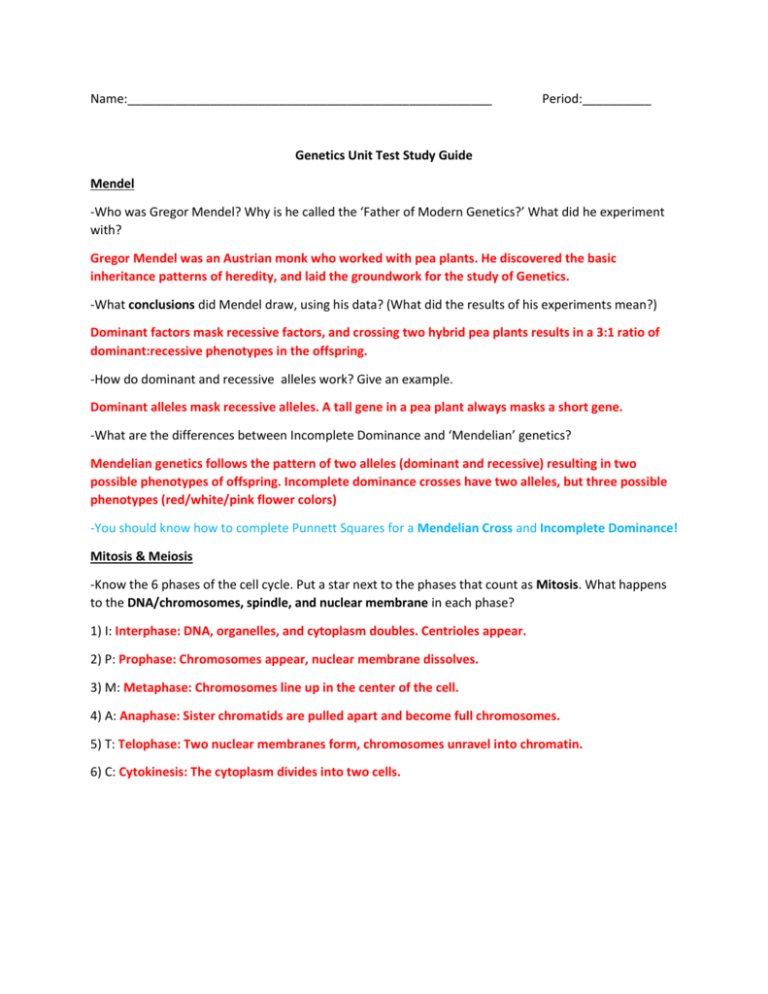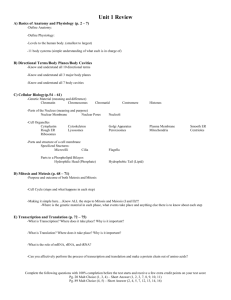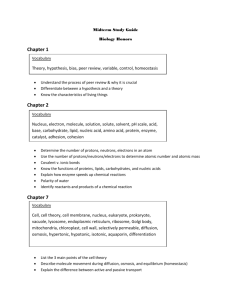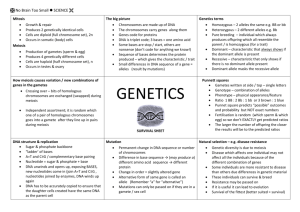Name: Period:______ Genetics Unit Test Study Guide Mendel
advertisement

Name:_____________________________________________________ Period:__________ Genetics Unit Test Study Guide Mendel -Who was Gregor Mendel? Why is he called the ‘Father of Modern Genetics?’ What did he experiment with? Gregor Mendel was an Austrian monk who worked with pea plants. He discovered the basic inheritance patterns of heredity, and laid the groundwork for the study of Genetics. -What conclusions did Mendel draw, using his data? (What did the results of his experiments mean?) Dominant factors mask recessive factors, and crossing two hybrid pea plants results in a 3:1 ratio of dominant:recessive phenotypes in the offspring. -How do dominant and recessive alleles work? Give an example. Dominant alleles mask recessive alleles. A tall gene in a pea plant always masks a short gene. -What are the differences between Incomplete Dominance and ‘Mendelian’ genetics? Mendelian genetics follows the pattern of two alleles (dominant and recessive) resulting in two possible phenotypes of offspring. Incomplete dominance crosses have two alleles, but three possible phenotypes (red/white/pink flower colors) -You should know how to complete Punnett Squares for a Mendelian Cross and Incomplete Dominance! Mitosis & Meiosis -Know the 6 phases of the cell cycle. Put a star next to the phases that count as Mitosis. What happens to the DNA/chromosomes, spindle, and nuclear membrane in each phase? 1) I: Interphase: DNA, organelles, and cytoplasm doubles. Centrioles appear. 2) P: Prophase: Chromosomes appear, nuclear membrane dissolves. 3) M: Metaphase: Chromosomes line up in the center of the cell. 4) A: Anaphase: Sister chromatids are pulled apart and become full chromosomes. 5) T: Telophase: Two nuclear membranes form, chromosomes unravel into chromatin. 6) C: Cytokinesis: The cytoplasm divides into two cells. Draw and label what the phases of Mitosis look like below. Prophase Metaphase Anaphase Telophase -What are the major differences between Mitosis and Meiosis? 1. Which cells use Mitosis to divide? Which cells use Meiosis to divide? Mitosis: all cells but sperm and egg Meiosis: sperm and egg 2. How many cells does each process make? Mitosis: two Meiosis: four 3. Draw and label Metaphase I and Anaphase I below. Remember: these occur only in Meiosis! Metaphase I Anaphase I DNA -What are the four nitrogen bases? Which base does each of these pair with? 1) Adenine pairs with Thymine 2) Cytosine pairs with Guanine -How is RNA different from DNA? -RNA is a single helix, DNA is a double helix. -RNA is used to transcribe/translate DNA -RNA has Uracil instead of Thymine -What is the function of RNA? What are the types of RNA? (REMOVED) RNA is used to decode the blueprint within DNA. -What is the goal of transcription and translation, as a process? To make a protein using the blueprint in your DNA. -Give a brief summary of Translation. How do you go from a fragment of mRNA to a protein? mRNA goes to the ribosomes, things inside of the ribosome translate the mRNA into a chain of amino acids, which makes a protein. -What is a chromosome? Chromatin? Sister chromatids? Chromosome: A bundle of chromatin that is supercoiled, appears in Prophase Chromatin: A long strand of DNA wrapped around histone proteins Sister Chromatids: The arms of a duplicated chromosome, which contain identical information -The sequence of base pairs in your DNA ultimately controls what? The traits of a given organism. Misc: -Why do children usually share some, but not all, of their traits with their parents? Children inherit half of their DNA from each parent, and recessive alleles can be passed from generation to generation without being expressed. -What things can cause mutations? Random chance, radiation, smoking, heredity. -What are some chromosomal errors that can cause mutations? (REMOVED) -What do all genetic disorders have in common? There is no cure, they can almost all be inherited, they come about from a change in your DNA. -How do viruses work? (REMOVED) -How can you tell if someone is male or female by looking at a karyotype? Look at the sex chromosomes: XY = Male, XX = Female -What else can you tell by looking at a karyotype? Presence of genetic disorders, species. -What do homozygous and heterozygous mean? Homozygous = two of the same alleles (TT or tt) Heterozygous = two different alleles (Tt) -Can you predict the features of a child of two parents just by looking at them? Why or why not? No, you cannot see the recessive alleles in the parents’ genome. -What do tRNA, mRNA, codons, and amino acids do? (REMOVED) mRNA: Mirror image of one half of a DNA template, used to decode the blueprint in DNA Amino Acids: Chain together to make a protein.









